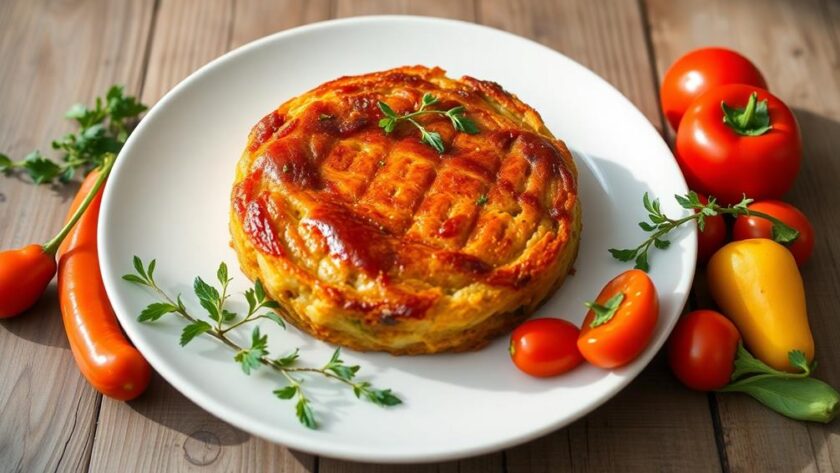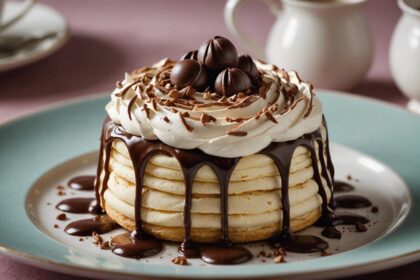Cabbage cake might surprise you with its deliciousness! This dish turns leftover cabbage into a flavorful delight. Start by sautéing finely chopped cabbage and onions in olive oil and butter. Combine this with a creamy ricotta blend before mixing with flour for structure. Bake until golden and serve with fresh herbs and a dollop of sour cream. The options for customization are endless—try adding herbs, spices, or even swapping in different veggies. You're sure to impress with this unexpected treat. Keep exploring to uncover more tips and tricks for perfecting your cabbage cake experience!
The Inspiration Behind Cabbage Cake
Cabbage cake emerged as a clever solution for using up leftover cabbage, transforming this often-overlooked vegetable into a delightful dish. Its historical origins trace back to various cultures, where resourcefulness in the kitchen has always been celebrated. People have long recognized cabbage's versatility, incorporating it into baked goods to create hearty meals that make the most of available ingredients.
This innovation reflects the spirit of nostalgic desserts and childhood memories, as families often look for creative ways to repurpose leftovers while still enjoying comforting flavors.
This dish carries cultural significance, showcasing how different communities have adapted traditional recipes to minimize waste. You'll find versions of cabbage cake across Europe and beyond, each with unique twists that reflect local tastes and customs. By blending cabbage with ingredients like onion, sour cream, and eggs, you get a rich, satisfying cake that surprises many with its deliciousness.
As cabbage cake gains popularity, it highlights a growing trend of using vegetables in unconventional recipes. You're not just enjoying a tasty treat; you're also participating in a culinary movement that values sustainability and creativity.
Essential Ingredients for Success
To create a delicious cabbage cake, you'll need a few essential ingredients that work together to enhance its flavor and texture. Start with a medium-sized cabbage, as it serves as the primary ingredient. Not only does cabbage provide a unique flavor, but it also offers numerous health benefits, such as being low in calories and high in fiber.
For a nutrient boost, consider incorporating nutrient-rich flours that can enhance both flavor and health benefits.
For richness, you'll sauté the cabbage and onion in 1 tablespoon of olive oil and 10 grams of butter. This step is important for developing depth in taste.
You'll also need two cups of flour to provide the cake with the structure it needs to rise and hold together, which is essential for achieving the right texture.
To keep the cake moist and creamy, incorporate liquid components like 1/2 cup of milk, a glass of water, and another glass of milk for the ricotta mixture.
Finally, don't forget to season with 1 teaspoon of salt, garlic powder, and pepper. These seasonings elevate the overall flavor profile, making your cabbage cake unexpectedly delicious and enjoyable!
Preparing the Cabbage Mixture
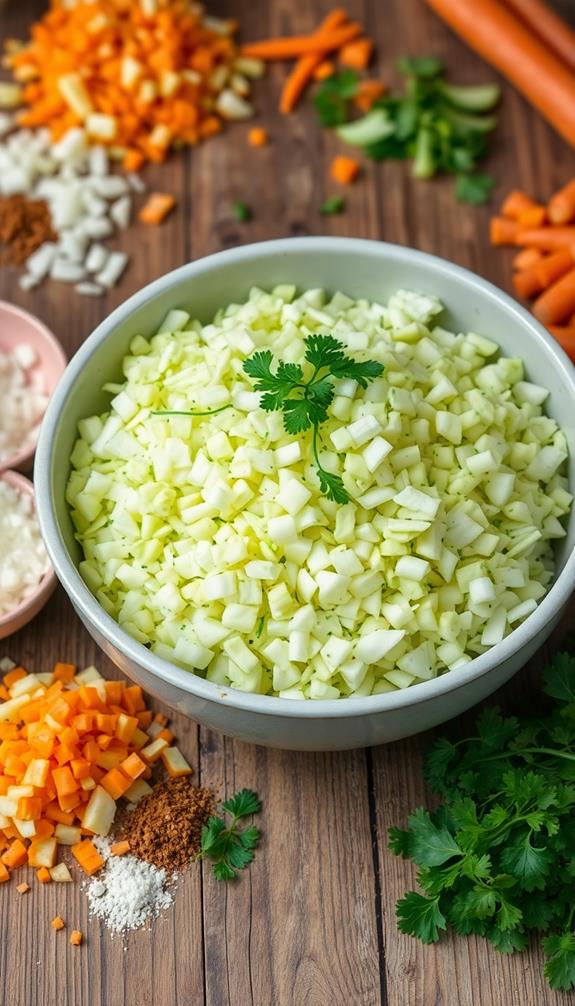
Start by finely chopping a medium-sized cabbage along with an onion.
Heat a mixture of 1 tablespoon of olive oil and 10 grams of butter in a skillet over medium heat.
Add the chopped cabbage and onion, then sauté them for about 15 minutes until they soften.
This cooking technique not only enhances their flavor but also creates a delightful texture contrast in your cabbage cake.
Incorporating ingredients like onions can also enhance the nutrient profile, similar to how high-protein vegan cookies are packed with essential nutrients.
Once the mixture cools slightly, mix in the eggs to create a cohesive filling.
The eggs help bind the cabbage and onion together, ensuring each bite is flavorful and satisfying.
In a separate bowl, combine 2 cups of flour with 1/2 cup of milk and any additional liquid components to achieve a smooth batter consistency.
This will serve as the base for your cake, adding structure to the dish.
For the final touch, fry the cabbage mixture in oil until it turns golden brown.
This step adds a rich, savory depth to the filling, making it even more irresistible.
Once done, you're ready to incorporate it into your baking dish, paving the way for the next steps in creating this unexpected delight!
Crafting the Ricotta Blend
To craft the ricotta blend, you'll start by mixing 200 g of sour cream or yogurt with eggs and seasonings like salt and garlic powder.
The creamy consistency of this blend is reminiscent of a delightful Coconut and Pineapple Oatmeal Delights, which adds a unique twist to your dish.
Make sure everything's well-combined for a smooth texture, then add a glass of milk to achieve a creamier consistency.
Don't forget to adjust the seasonings to your taste, as this blend will elevate the flavors of your cabbage cake.
Ingredients for Ricotta Blend
Creating a delicious ricotta blend is important for your cabbage cake, and you'll need just a few key ingredients to get started.
Begin with 200 grams of ricotta, choosing from various ricotta varieties like whole milk or part-skim, depending on your desired creaminess. To enhance the texture, mix in 200 grams of sour cream or yogurt along with the specified amount of eggs.
Once you've got your base, season the mixture with 1 teaspoon of salt, 1 teaspoon of garlic powder, and 1 teaspoon of pepper. These simple flavor pairings elevate the overall taste and guarantee your cabbage cake is anything but bland.
For an extra twist, don't hesitate to experiment with additional spices or herbs like oregano or thyme, which can add unique depth to your dish.
This ricotta blend is essential for adding moisture and richness to the cake, preventing it from drying out during baking.
After mixing, be certain to blend the ricotta thoroughly with the cabbage mixture for an even distribution of flavors. This step is critical for creating a cohesive and delicious final product.
Mixing Techniques Explained
Mixing techniques play an essential role in crafting the perfect ricotta blend for your cabbage cake. Start by combining 200 g of sour cream or yogurt with eggs and seasonings like salt, garlic powder, and pepper.
Using effective mixing methods, you'll want to whisk or use a fork to thoroughly incorporate these ingredients. This step is vital to avoid lumps, which can negatively impact the texture of the final dish.
Pay attention to texture importance; a smooth, creamy consistency is your goal. Adjust the seasoning in the ricotta blend according to your taste—don't hesitate to add more salt or pepper if you feel it's necessary.
Once your ricotta mixture is well-blended, it's time to gently fold it into the cabbage filling. This gentle incorporation is key to maintaining the airy texture of the ricotta while ensuring an even distribution within the cake.
Flavor Enhancements Options
Enhancing the flavor of your ricotta blend can elevate your cabbage cake to new heights. Start by incorporating fresh herb combinations like dill or parsley, which can brighten the overall taste.
Next, explore cheese selections; adding grated Parmesan or mozzarella introduces a rich, creamy texture and savory depth that pairs beautifully with the cabbage.
For those who enjoy a bit of heat, spice additions such as red pepper flakes or smoked paprika can give your ricotta a delightful kick, enhancing the dish's flavor profile.
Don't forget about citrus enhancements—just a tablespoon of lemon juice or zest can bring a revitalizing tang that balances the richness of the sour cream.
Lastly, seasoning variations are key; experiment with Italian seasoning or a sprinkle of nutmeg to add unique flavor dimensions.
These adjustments not only enhance taste but also create texture contrasts that make each bite interesting. By thoughtfully combining these elements, you'll craft a ricotta blend that turns your cabbage cake into a truly unforgettable dish.
Enjoy the process and let your creativity shine!
Cooking Techniques Explained
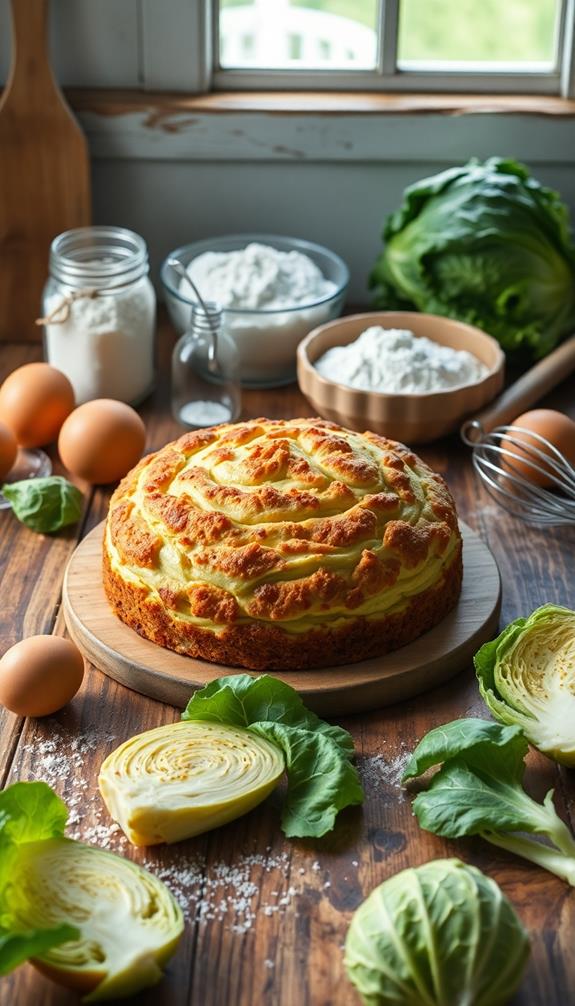
When it comes to cooking techniques, understanding the role of each ingredient and process can elevate your dishes greatly. For the cabbage cake, you'll start by using a combination of cooking methods. Simmering cabbage with onions in olive oil and butter softens the vegetables while enhancing their flavor profiles, setting a solid foundation for your cake.
Additionally, consider the importance of measuring ingredients accurately, as properly measured dry ingredients are essential for achieving the right texture and rise in baked goods.
Next, incorporate eggs into the mixture. They not only add richness but also help bind the ingredients together, improving the overall texture. When you combine flour with liquid components like milk, you create a batter that supports the cabbage filling, ensuring a sturdy structure.
Frying the cabbage mixture until golden is critical. This step adds a delightful layer of texture and deepens the flavors through the Maillard reaction, which occurs during browning.
Baking to Perfection
Baking is an art that requires attention to detail, especially when creating a unique dish like cabbage cake. To achieve the best results, you'll want to master a few essential baking techniques and guarantee your oven settings are just right. For added health benefits, consider incorporating healthier ingredient swaps to elevate your dish.
- Preheat your oven to 180°C (350°F) for even baking and ideal rise.
- Transfer the prepared cabbage mixture into a greased baking dish to prevent sticking.
- Bake the cake for 30 minutes, allowing the flavors to meld and the top to develop a lovely golden color.
- Use a toothpick to check for doneness; it should come out clean when the cake is ready.
Following these steps will help you achieve a perfectly baked cabbage cake. The preheating step is vital, as it sets the stage for the entire baking process.
Once you've baked the cake, let it cool before serving. This cooling period enhances the texture and makes slicing much easier.
Serving Suggestions and Pairings
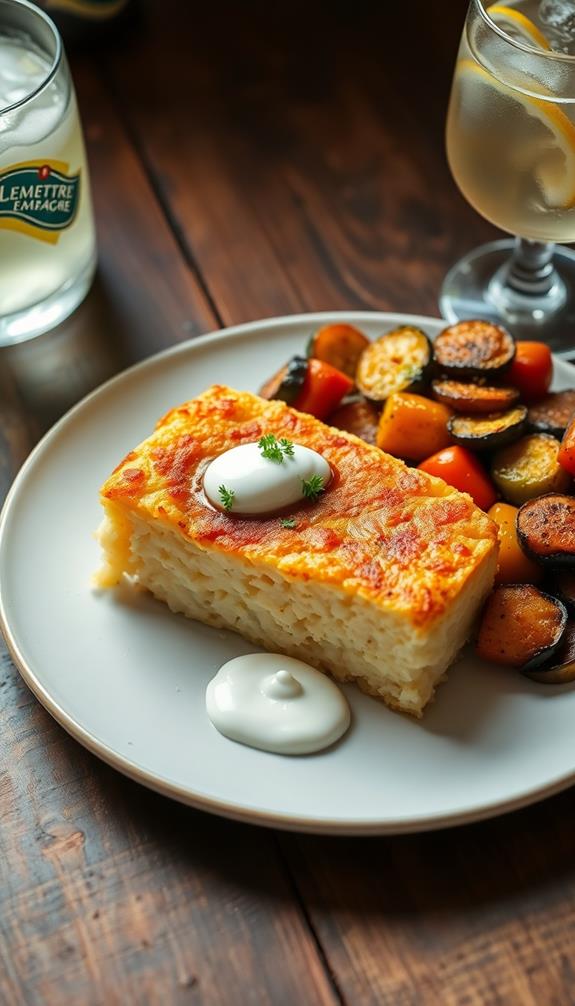
When serving your cabbage cake, think about pairing it with a light salad or pickled vegetables for a revitalizing contrast.
Adding a side of protein-packed cookies can boost the nutritional value of your meal and provide a satisfying snack option.
A dollop of sour cream can enhance the cake's flavor, while a glass of crisp white wine or a light beer rounds out the meal beautifully.
These choices will elevate your dining experience and complement the savory notes of the cake.
Best Side Dishes
Cabbage cake's unique flavors invite a variety of delightful side dishes that can elevate your meal. To create the perfect pairings, consider these fantastic options that will complement the savory goodness of your cabbage cake:
- Tangy beet salad: This earthy and sweet dish enhances the flavor profile of the cake.
- Creamy garlic yogurt sauce: A revitalizing condiment that contrasts beautifully with the cake's richness.
- Roasted potatoes: Seasoned with rosemary and garlic, these hearty potatoes create a comforting side dish.
- Steamed green beans or asparagus: Drizzled with lemon juice, they add a bright, crunchy element that complements the cake's texture.
A light tomato and cucumber salad is another excellent choice, providing a rejuvenating balance to the richness of the cabbage cake.
Wine Pairing Recommendations
Pairing the right wine with your cabbage cake can elevate your dining experience even further.
For a crisp and rejuvenating choice, try a Sauvignon Blanc. Its bright acidity enhances the savory flavors of the cake without overwhelming them.
If you're in the mood for red, a light-bodied Pinot Noir complements the caramelized notes from the sautéed cabbage and onions beautifully.
Looking for something bubbly? A dry Prosecco is an excellent choice, as it provides a revitalizing contrast to the dish's creaminess.
If you enjoy Chardonnay, opt for a well-chilled version with a hint of oak. This will bring out the buttery flavor of the cabbage cake thanks to its creamy texture.
For a unique twist, consider an off-dry Riesling. Its pleasant sweetness can soften the savory elements of the cabbage cake, creating a delightful balance.
Each of these wine pairings enhances the flavors of your dish, making your meal even more enjoyable.
Garnishes to Enhance Flavor
Enhancing your cabbage cake with the right garnishes can make all the difference in flavor and presentation. By thoughtfully selecting garnish combinations, you can introduce delightful flavor contrasts that elevate your dish. Here are some ideas to contemplate:
- A dollop of sour cream or yogurt on top adds a creamy texture that complements the savory flavors of the cake.
- Freshly chopped herbs like dill or parsley not only beautify the presentation but also bring a fresh, aromatic element to each bite.
- Pair your cabbage cake with a light cucumber and tomato salad for a rejuvenating contrast to its richness.
- Drizzle a balsamic reduction over the top for a sweet and tangy finish that enhances the overall flavor profile.
For a bit of heat, sprinkle red pepper flakes or serve with a spicy dipping sauce on the side.
These simple yet effective garnishes will transform your cabbage cake into a delicious centerpiece that impresses your guests and delights your taste buds.
Enjoy experimenting with these ideas to find your perfect combination!
Tips for Variations and Customization
When you're ready to put your own spin on the cabbage cake, there are plenty of exciting ways to customize it. One great approach is to experiment with veggie swaps. Consider adding grated carrots or zucchini to the cabbage mixture; these additions boost flavor and nutrition, making your cake even more delightful.
You might also think about incorporating some nutrient-rich ingredients such as almond flour, which not only adds a gluten-free option but also enhances the texture and flavor of your dish.
You can also enhance the taste profile by incorporating fresh herbs like dill or parsley into the ricotta mixture. These herbs add a fresh, aromatic touch that elevates your dish.
If you're looking to cater to specific dietary preferences, try substituting half of the flour with whole wheat flour or a gluten-free alternative.
For those who enjoy a little heat, adjust the spice levels by mixing in some chopped jalapeños or red pepper flakes into the cabbage mixture. This gives your cake an exciting kick that will tantalize your taste buds.
Conclusion
In the end, trying cabbage cake might feel like diving into the unknown, much like a child taking their first leap into a pool. At first, it's a bit intimidating, but once you're in, the invigorating surprise of flavors makes it all worthwhile. This cake teaches us that embracing the unexpected can lead to delightful discoveries. So go ahead—bake it, share it, and let your taste buds celebrate the joy of culinary adventure!

